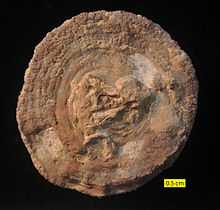Beekite

Base of the scleractinian coral Microsolena showing beekite rings; Middle Jurassic of southern Israel.
Beekite is a distinctive form of chalcedony sometimes associated with silicified fossils.
Beekite, recognised as small, concentric rings of microcrystalline quartz is recorded as first brought to attention of geologists by Dr Beeke, Dean of Bristol.[1] Studies were reported by Thomas McKenny Hughes, in Devon,[2] and Etheridge in Australia [3]
References
- ↑ Henry William Bristow, F.G.S. (1861). Glossary of Mineralogy. London: Longman, Green, Longman, and Roberts. pp. 38–39. Retrieved 14 November 2014. (Archived at the Biodiversity Heritage Library)
- ↑ T. M. McKenny Hughes, M.A., F.R.S (1889). "On the manner of occurrence of Beekite and its bearing upon the origin of Siliceous Beds of Palaeozoic Age" (PDF). The Mineralogical Magazine and Journal of the Mineralogical Society (London: Simpkin, Marshall, Hamilton, Kent & Co., Ltd.) 8: 265–271. doi:10.1180/minmag.1889.008.40.02. Retrieved 14 November 2014.
- ↑ R. Etheridge, Jnr. (1893). "On the occurrence of Beekite in connection with "fossil organic remains" in New South Wales" (PDF). Records of the Australian Museum 2 (5): 74–76, plate xvi. doi:10.3853/j.0067-1975.2.1893.1197. Retrieved 14 November 2014.
| ||||||||||||||||||||||||||||||||